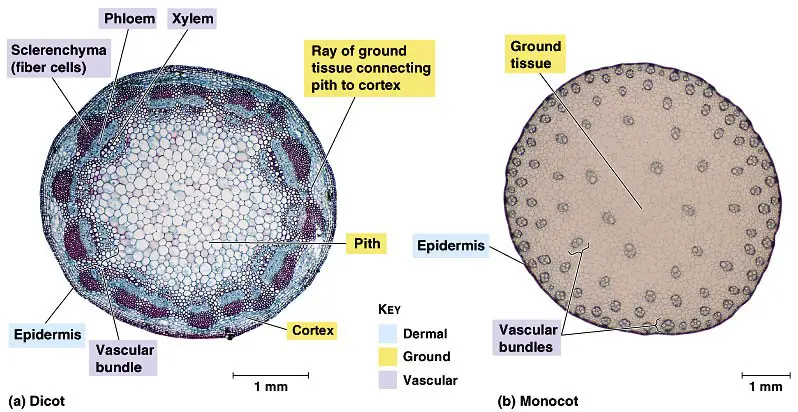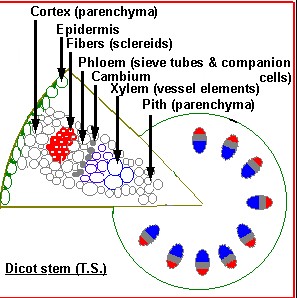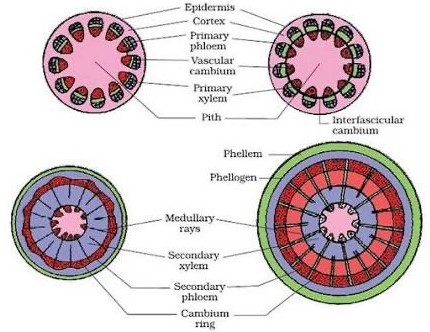The plant kingdom showcases a diversity that often goes unnoticed, especially when it comes to the anatomical differences that lie beneath the surface. One such distinction, crucial yet commonly overlooked, is between the stems of herbaceous monocots and dicots. These differences are not just minute details; they are fundamental to how these plants interact with their environments, grow, and fulfill their roles in ecosystems.
Herbaceous monocot stems are characterized by scattered vascular bundles, while dicot stems typically feature vascular bundles in a ring arrangement. This primary difference affects not only the plant’s overall structure and strength but also its ability to transport water and nutrients. Additionally, the presence or absence of a cambium layer contributes to a plant’s capacity for secondary growth, distinguishing monocots and dicots further in terms of longevity and size.
Moving beyond the surface, these distinctions delve deep into the plant’s physiology, influencing everything from growth patterns to how they respond to environmental stressors. The structural nuances of herbaceous monocot and dicot stems play a pivotal role in agricultural practices, botanical research, and our understanding of plant biodiversity. This exploration into their anatomy not only enriches our knowledge but also highlights the intricate beauty of plant life.

Basic Differences
When diving into the world of botany, distinguishing between monocots and dicots emerges as a fundamental step. These two groups of angiosperms, or flowering plants, present a variety of differences that significantly impact their growth, development, and overall structure.
Monocot vs Dicot
At the heart of the distinction between monocots and dicots lies their seed structure. Monocots, short for monocotyledons, possess a single embryonic leaf or cotyledon. In contrast, dicots, or dicotyledons, feature two of these embryonic leaves. This difference is the tip of the iceberg, leading to a cascade of anatomical and physiological distinctions.
- Leaf Venation: Monocots exhibit parallel venation, where veins run in straight lines across the leaf. Dicots display a reticulate venation pattern, creating a network of interconnecting veins.
- Root Systems: Monocots develop a fibrous root system, a network of roots of similar size, while dicots typically have a taproot system, with one large, central root and smaller lateral ones.
- Floral Parts: In monocots, floral parts come in multiples of three. Dicots, however, have floral parts in multiples of four or five.
- Stem Vascular Bundles: Monocots have scattered vascular bundles across the stem, whereas dicots arrange these bundles in a ring.
Stem Structure
The stem is more than just a support structure for leaves and flowers; it’s a vital conduit for water, nutrients, and sugars, integral to a plant’s survival and growth. The stem’s anatomy, especially the arrangement and type of vascular tissue, plays a crucial role in differentiating monocots from dicots.
Anatomy of Monocot Stems
Monocot stems, such as those found in grasses and lilies, showcase unique features tailored to their growth habits and environments.
Vascular Bundles
Monocot stems are characterized by their scattered vascular bundles. Unlike the ring-like pattern seen in dicots, these bundles are spread throughout the stem’s cross-section. Each bundle is surrounded by a sheath of sclerenchyma or parenchyma cells, providing structural support.
- Function: These bundles ensure efficient transport of water and nutrients, vital for photosynthesis and growth.
- Characteristics: The bundles lack a cambium layer, meaning monocots typically do not undergo secondary growth (increasing in width).
Ground Tissue
In monocots, the ground tissue, or parenchyma, fills the spaces between the vascular bundles. This tissue is crucial for storage and photosynthesis.
- Composition: Made up primarily of parenchyma cells, which store nutrients and water.
- Function: Supports the plant structurally and plays a role in metabolism and storage.
Epidermis
The outermost layer of monocot stems, the epidermis, serves as a protective barrier against physical damage and water loss.
- Structure: It consists of tightly packed cells, covered with a waxy cuticle to minimize water loss.
- Role: Beyond protection, the epidermis also facilitates gas exchange through stomata, microscopic openings controlled by guard cells.
Anatomy of Dicot Stems
Dicot stems, found in plants like beans and roses, differ markedly from their monocot counterparts, reflecting their varied lifestyles and ecological roles.
Vascular Bundles
Dicot stems organize their vascular bundles in a distinct ring pattern, separating the inner pith from the outer cortex.
- Arrangement: This ringed arrangement supports the stem and allows for efficient transport of nutrients and water.
- Distinguishing Features: Unlike monocots, dicots have a cambium layer within the vascular bundles, enabling secondary growth. This cambium is a meristematic tissue that allows the stem to increase in girth over time.
Ground Tissue
The ground tissue in dicots serves multiple functions, from storage to support, and is divided into the pith and the cortex.
- Composition: Comprised of parenchyma, collenchyma, and sclerenchyma cells, each type serving distinct roles in support, storage, and structural integrity.
- Significance: The ground tissue’s arrangement and diversity of cell types contribute to the dicot stem’s strength and ability to undergo secondary growth.
Epidermis
Dicot stems feature an epidermis similar in function to that of monocots but differ in the potential for secondary growth.
- Structural Differences: The epidermis in dicots can be replaced by a protective layer called the periderm, as the stem undergoes secondary growth.
- Role: Protects the stem, manages water loss, and allows gas exchange, similar to monocot stems but adapted to the dicot’s growth pattern.

Key Differences Highlighted
Exploring the anatomy of monocots and dicots unveils a fascinating world of structural diversity, crucial for their survival and function. The distinction between these two groups lies at the heart of botany and has significant implications across various fields.
Vascular Bundle Arrangement
Monocots
In monocots, vascular bundles are scattered throughout the stem’s cross-section. This pattern supports a robust structural framework, enabling monocots to stand tall and resist bending.
Dicots
Dicots, in contrast, organize their vascular bundles in a distinct ring. This arrangement facilitates efficient transport of nutrients and supports secondary growth, allowing dicots to thicken and strengthen over time.
The contrast in vascular bundle arrangement between monocots and dicots reflects their adaptation to different environments and life strategies.
Ground Tissue Comparison
Composition and Function in Monocots
Monocots’ ground tissue predominantly consists of parenchyma cells, serving as a critical area for storage and photosynthesis. This tissue’s flexibility supports the scattered vascular bundle arrangement, adapting to various environmental pressures.
Composition and Function in Dicots
Dicots feature a more complex ground tissue structure, divided into cortex and pith. These areas not only provide support and storage but also play a vital role in secondary growth, contributing to the plant’s overall strength and stability.
The differences in ground tissue structure underline the unique physiological needs and growth patterns of monocots and dicots.
Epidermal Layer Differences
Monocot Epidermis
Monocots have a single-layered epidermis with a thick cuticle, primarily designed to minimize water loss and protect against external threats. Stomata are evenly distributed, facilitating gas exchange.
Dicot Epidermis
Dicot epidermis may evolve into a more complex structure with the development of trichomes and stomatal regulation. The potential for secondary growth leads to the formation of protective bark, adapting to terrestrial life.
The epidermal layer in both groups underscores their evolutionary adaptations, offering insights into their ecological niches and survival strategies.
Physiological Differences
Water Transportation
The stem’s structure plays a crucial role in water and nutrient transport, with monocots and dicots adopting different strategies. Monocots, with their scattered vascular bundles, specialize in efficient vertical transport, supporting their generally upright growth. Dicots, thanks to their ringed vascular bundles and secondary growth, can support a more extensive transport network, crucial for larger plant structures.
Growth Patterns
Monocots typically exhibit primary growth, focusing on height and root spread. Dicots, with the capacity for secondary growth, can expand in girth, allowing for a broader range of growth forms, from shrubs to towering trees. This diversity in growth patterns reflects their adaptation to various ecological roles and environments.
Practical Implications
Agricultural Considerations
Understanding the differences between monocots and dicots has profound implications for agriculture. From crop rotation strategies to pest management and fertilizer application, recognizing these groups’ distinct needs can lead to more sustainable and productive farming practices.
- Monocots: With their fibrous root systems and efficient nutrient transport, monocots like wheat and corn are pivotal in crop rotation, aiding in soil stabilization and fertility.
- Dicots: Dicots, such as legumes, play a crucial role in nitrogen fixation, improving soil quality and supporting subsequent monocot crops.
Botanical Research
The structural differences between monocots and dicots are not just academic distinctions; they form the foundation of botanical research and plant classification. Understanding these differences aids in the identification of unknown species, the study of evolutionary relationships, and the development of new plant varieties better suited to human needs.
- Taxonomy: The classification and naming of plants rely heavily on distinguishing between monocots and dicots, facilitating the organization of botanical knowledge.
- Evolutionary Biology: Analyzing these differences helps scientists understand plant evolution, offering insights into how plants have adapted to their environments over millions of years.

Frequently Asked Questions
What are herbaceous plants?
Herbaceous plants are those that have non-woody stems, typically dying back at the end of the growing season. They are known for their soft, flexible, and green stems, which distinguish them from woody plants. These plants play crucial roles in ecosystems, serving as food sources, ground cover, and habitat for various organisms.
How do monocots and dicots differ?
Monocots and dicots differ primarily in their seed structure, leaf vein pattern, root system, flower parts, and stem anatomy. Monocots have a single seed leaf, parallel leaf veins, a fibrous root system, flower parts in multiples of three, and scattered vascular bundles. Dicots, on the other hand, have two seed leaves, netted leaf veins, a taproot system, flower parts in multiples of four or five, and vascular bundles arranged in a ring.
Why is stem anatomy important in plants?
Stem anatomy is crucial for understanding a plant’s growth, support, water and nutrient transport, and survival mechanisms. It determines how a plant stands upright, distributes water and nutrients from the roots to the leaves and flowers, and supports secondary growth. Different stem structures offer various adaptations, helping plants thrive in diverse environments and ecological niches.
Conclusion
The journey through the anatomy of herbaceous monocot and dicot stems unveils a world of complexity and adaptation. These distinctions are not merely academic; they influence everything from the survival strategies of individual plants to agricultural practices and ecological balance. By appreciating these differences, we gain insights into the resilience and diversity of plant life, a testament to nature’s ingenuity.
Understanding the anatomical differences between herbaceous monocot and dicot stems enriches our appreciation for the plant kingdom’s diversity. It also underscores the importance of botanical knowledge in sustainable agriculture, conservation efforts, and the study of plant evolution. As we continue to explore and learn from the natural world, these distinctions remind us of the intricate relationships that sustain life on our planet.
